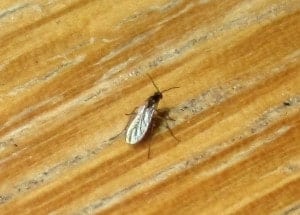Everyone knows these little flies flickering over the pots of plants. Sometimes there are almost none; sometimes there are hundreds of them. What damage do fungus gnats cause? Whether you are dealing with larvae or adults, buying infested seedling soil, or a new flower without paying attention to the pest’s signs, these are common pests on plants grown indoors.
When the humidity level in the room is high, they are not dangerous, but if you find the fungus gnats on plants, it’s time to pound the alarms. Let me explain how to identify these pests and give some tips on fungus gnat removal.
What Are Fungus Gnats?
Fungus gnats (Sciaridae) belong to the order of Diptera insects (true flies) of the Sciaridae family. An individual has a rounded head, a flat and narrow body, a pair of wings, and a size of only 3-4mm. Now, let’s talk about fungus gnats on plants in more detail.
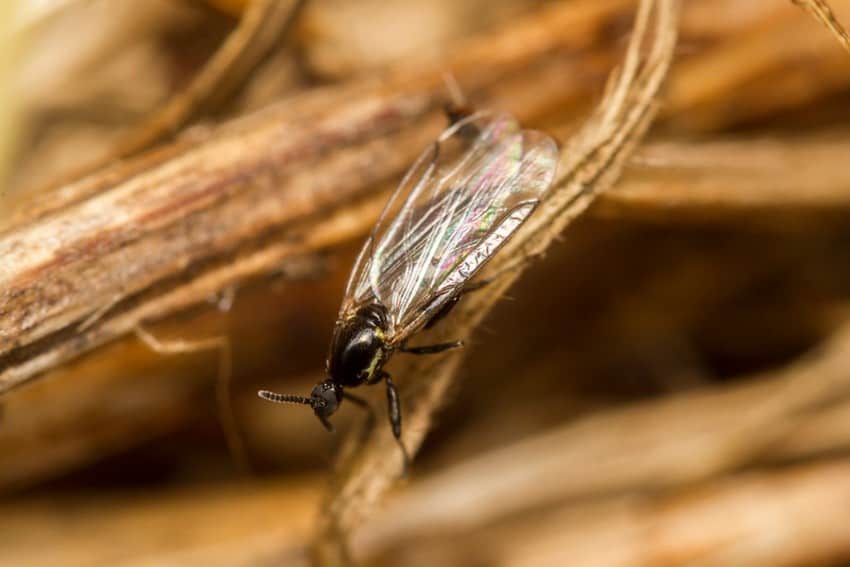
Visual identification
How to know that you have fungus gnats? The adults most often look like black flies with an elongated body about 3-4 mm long. Their larvae are whitish, translucent eggs in the roots of plants. Young gnats can be about 1.5-2 mm and are light gray.
Lifecycle
These insects do not live long. Adults live for about a week but can leave up to 300 eggs in the soil. The pupal stage lasts about 3-4 days, then the grown individuals leave the soil, but do not fly far, even during watering. The entire cycle from egg to adult insect takes 3-4 weeks, depending on the temperature in the room.
What do fungus gnats eat?
Fungus gnats larvae and adults feed on plant roots, causing significant damage to the plant. The larvae destroy the roots of plants. Many individuals can easily ruin tubers and the lower part of the stem or leaves near the ground. The damaged areas of the roots can become foci of fungal infections. If you would not take steps of fungus gnat removal, your plants will die immediately.

Where do fungus gnats come from?
The reasons are several factors: waterlogging, decaying remains, a new flower, insufficiently disinfected soil for transplanting or planting a new plant. So, before getting rid of fungus gnats indoors, you have to know the exact reason for their appearance.
Sciarids, like all flying insects, can enter a room through open vents, windows, and just an open door. You can also bring home an infected plant from the store or bring in the larvae from poorly disinfected soil.
But if you noticed fungus gnats in your house, it doesn’t always mean that you already have a whole infestation. The thing is that gnats leave their larvae in particular conditions. For example, a perfect place for gnats infestation is the soil, with a process of decay or decomposition of organic fertilizers.
Therefore, first of all, fungus gnats lay eggs in pots with plants poured with tinctures of mullein or bird litter. Many people also notice that fungus gnats tend to appear when you are using water from an aquarium for irrigation, along with the waste products of fish.
Fungus gnat dangers: can these flies really cause damage?
In fact, most damage to the plants is brought by fungus gnats larvae. They feed on the delicate tips of the roots, thereby undermining the essential vitality of the plant. A plant with an affected root system usually gets sick, withers, does not bloom, and, as a result, dies.
Mainly, insects spoil the appearance of the plant with their presence. However, if the number of gnats increases significantly, they begin to feed on the plant’s aerial parts, preferring young and tender shoots.
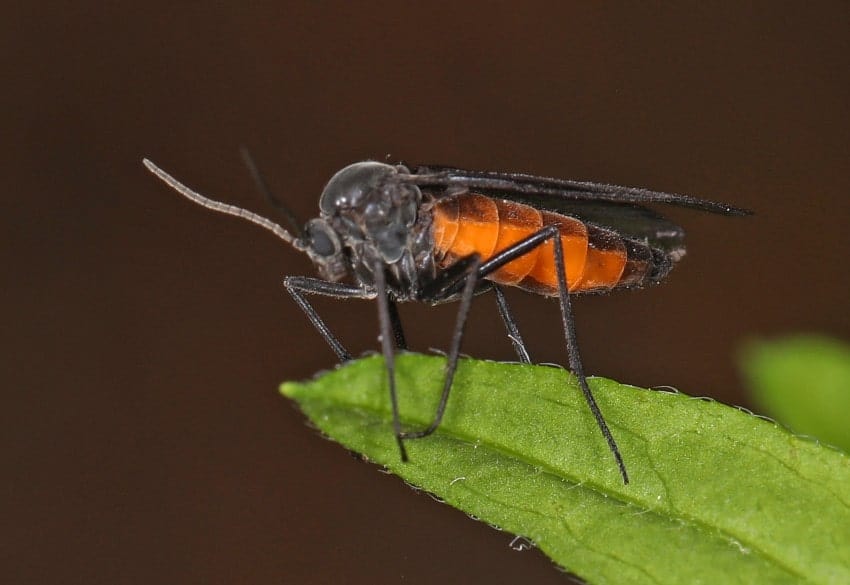
The larvae feed not only on decaying organic material, algae, or fungi but also on the root system and stem’s active tissue. They pierce the root and stem of a cutting, seedling, or young plant. The result is a secondary spread of various phyto-diseases such as Pythium, Phytophthora, Botrytis, Fusarium, and Verticillium. The main symptoms of pest damage are wilting and growth retardation.
Signs of the fungus gnat infestation
Fungus gnats in potted plants are a result of excessive watering and constant humidity. Flowers, where adult insects have already laid eggs, have a poor condition. Sluggish leaves, loss of healthy plant color, and many other signs are the main symptoms of gnats infestation.
If you found the fungus gnats, you have to treat the plants with special aerosols and hang glue traps near the plant. So, start examining your flowers and soil. The very first sign of these insects is, of course, fluttering flies around potted plants.
Less obvious symptoms include:
- white larvae in the ground;
- sudden wilting of the plant;
- poor growth of young plants;
- yellowish leaves.
Did you find the gnats on your flowers? The first rule is not to panic. The chances of saving your favorite orchid or violet are great. But the battle for salvation must begin immediately.
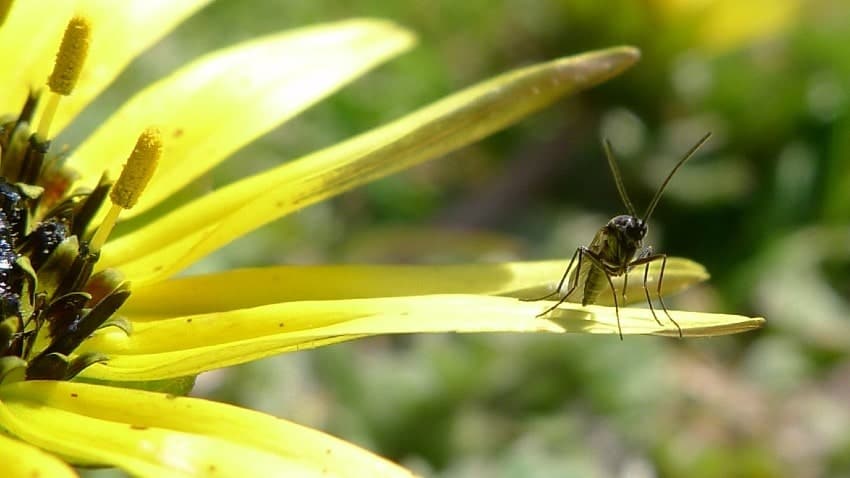
How to Get Rid of Fungus Gnats: A Step-by-Step Guide
If you discovered the signs of these pests attack, you might want to consider several effective measures to deal with fungus gnats on your plants.
Step 1: Examine a new plant carefully
Before purchasing potted plants, gently lift the soil near the base of the plant and look for larvae. Of course, if you noticed that there are small insects flying around the plant, it’s already infested.
Step 2: Add some sand to the soil
Add a thin layer of sand to the soil of your potted plant. If there is a problem, sprinkle a 1.5cm layer of sand on the surface of the soil. This will prevent adult gnats from laying eggs and will also act as a barrier to the surface.
Step 3: Use a synthetic fabric for the base of the pot
Cover the drain holes with a synthetic cloth. These insects tend to stay near the surface of flowerpots or seedling containers, but sometimes they get into drainage holes on the underside to lay eggs. So, take a piece of synthetic fabric, wrap it around the base of the pot, and secure it with an elastic band. Such material freely passes water, but won’t let the insects in.
Step 4: Dry the soil
When you find eggs, the first thing you need to do is let the soil dry to a depth of at least 3-5 cm between waterings. Dry soil kills larvae and stops egg development, and also makes the soil less attractive to egg-laying females.
Step 5: Get rid of fungus gnats
There are several ways to get rid of fungus gnats if the methods stated above didn’t work.
- Use adhesive tapes
Classic yellow sticky traps are an excellent way to reduce pest populations. You can hang them near plants, and they will attract adult gnats. For seedlings, place traps horizontally on the soil surface to collect large numbers of egg-laying adult females. The yellow sticky traps are easy to use and affordable. When the trap is full, remove it and place a new one.
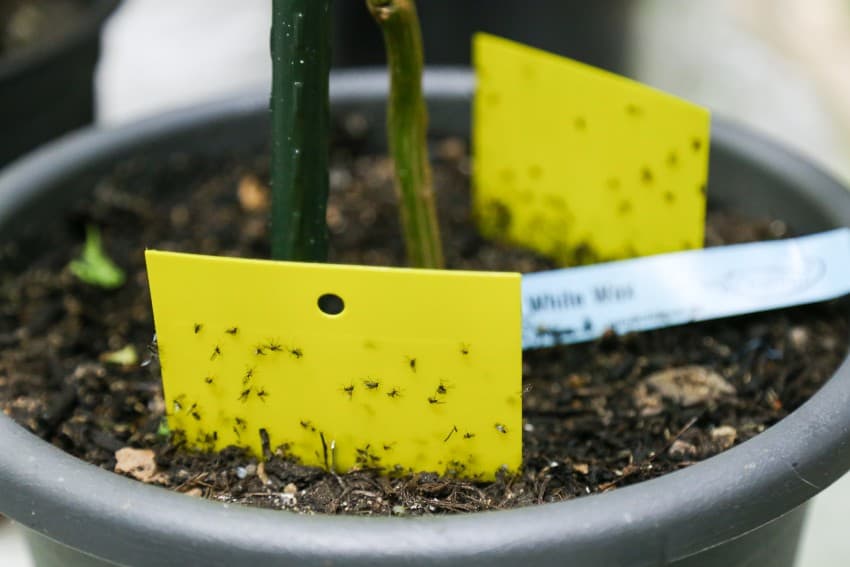
- DIY vinegar trap
Pour an equal amount of apple cider vinegar and water into a shallow bowl (the best option is a canned fish) and add a drop of liquid soap or dishwashing treatment. Put a plastic cap on top and secure it with an elastic band. Then poke holes in the plastic, so the insects will be trapped and not able to escape. Now place the jar as close to the flowerpot or seedling container as possible. Change the solution every three days.
- Apply some diatomaceous earth
It is an organic abrasive powder that works well against different types of mosquitoes, including fungus gnats. The powder sticks to insects, dehydrating, and immobilizing them. Sprinkle it on the soil surface only when the soil is dry. Otherwise, the diatomaceous earth will absorb moisture and not stick to insects. The method is more effective when combined with sanding. Diatomaceous earth also helps to fight against larvae, as it contains microscopic fragments of silica, which physically injure insects upon contact. Thus, mix the diatomaceous earth with the top layer of the soil for the best effect.
Mix one part 3% hydrogen peroxide with four parts of water. Let the topsoil dry and then water as usual. The soil will “sizzle” immediately after application, but this is normal. After a few minutes, the hissing will stop, the peroxide breaks down into harmless oxygen and water molecules, and the larvae will die right after the contact with the mixture.
You can also get rid of sciarids in houseplants using a fumigator. Its location should be close to window sills or shelves with flowers. If fungus gnats are in a large room, you will need to use several fumigators. Before using the fumigator, close the doors and windows and leave the device for a day. Replace the treatment in the device every two hours.
Remember to loosen the topsoil. Periodic loosening will not only enrich the roots with oxygen but also enable the soil to dry out faster. Besides, larvae in the open air will die quickly. During loosening, it is necessary to inspect the soil to find out whether small insects or their larvae have bred in it.
[su_note note_color=”#e5e2d4″]Related post: How to Get Rid of Whiteflies[/su_note]
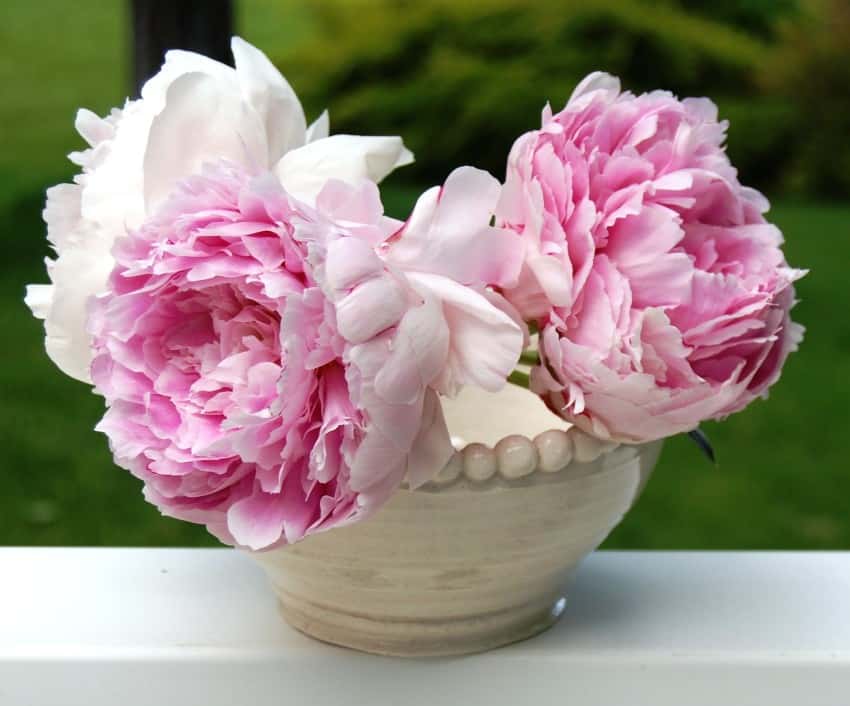
It may happen that even the use of special means will not bring a positive result. Again, do not despair, because not all methods have been used yet. At least, there is one effective and proven method that will 100% work. Transplant the flower into a pot of fresh soil. It is necessary to examine the entire root system thoroughly and treat it with special means.
Top 5 Fungus Gnats Treatments
Check out these options for successful fungus gnats control. All of the options were tested by me and some of my colleagues.
1. Kensizer Yellow Sticky Gnat Traps – The Best Solution for Getting Rid of Fungus Gnats on Plants
[amazon box=”B07KRRJT5J” template=”vertical” tracking_id=”how-to-get-rid-of-fungus-gnats-20″ button_text=”Check price on Amazon”]
Specifications:
- Color: Yellow
- Material: Paper
- Number of Pieces: 20
- Item Weight: 8.8 ounces
- Product Dimensions: 8 x 6 x 0.4 inches
- Target Species: Fly, Thrip, Mosquito, White Fly, Gnat
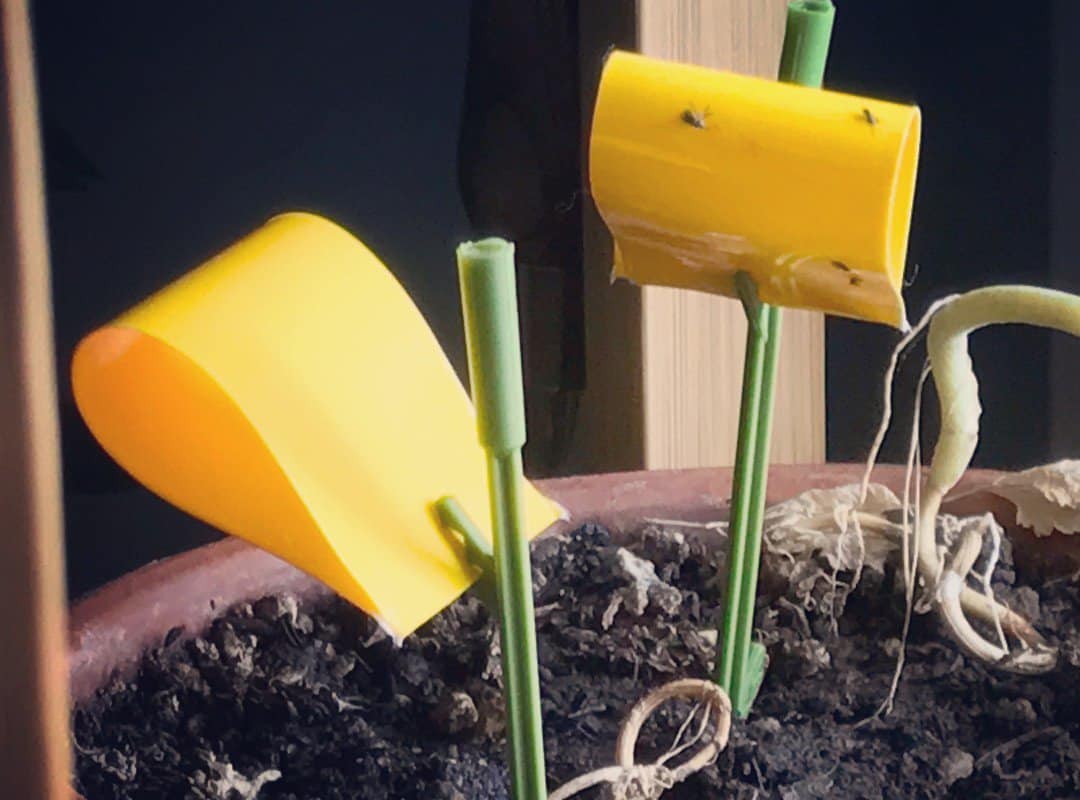
Kensizer product is a double-sided yellow paper that attracts many kinds of insects, including fungus gnats. There is a layer of a protected entomological glue on both sides, so when you want to use the trap, just take the layer off. It is quite easy to use.
Resistant to the aggressive action of high humidity and temperature, the glue, which is used in traps, has high stickiness, is non-toxic, does not drip, and does not run off. You can use it both indoors and outdoors since it is resistant to weather and temperature conditions. The bright yellow color attracts insects to the sticky surface, and a light touch of the glue surface is enough for the insect to get stuck. The pack includes 20 tapes, and it’s enough to get rid of a whole infestation.
| Pros: | Cons: |
|
|
2. Useful Option for Getting Rid of Gnats in Potted Plants: Trappify Sticky Fruit Fly and Gnat Trap
[amazon box=”B07JL8L79Q” template=”vertical” tracking_id=”how-to-get-rid-of-fungus-gnats-20″ button_text=”Check price on Amazon”]
Specifications:
- Color: Green/Yellow
- Material: Plastic
- Number of Pieces: 12
- Item Weight: 0.37 Pounds
- Product Dimensions: 5.2 x 3.3 x 0.1 inches
- Target Species: White Flies, Mosquitos, Flying Insects
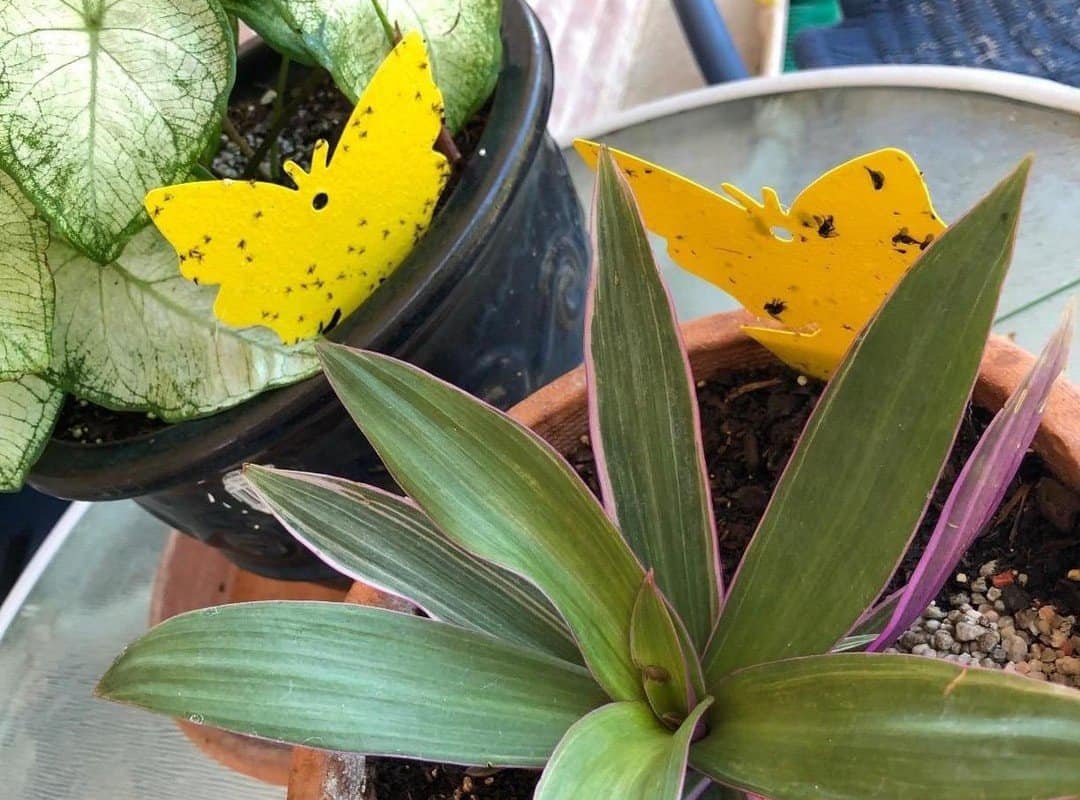
This is one of my favorite products ever. The pack includes 25 replaceable sticky traps, and it provides a 100% effect within several days. The Trappify product suits battling fungus gnats, flies, mosquitoes, ticks, and other pests. So, by purchasing it, you will save some cash and get a multifunctional treatment.
Getting rid of fungus gnats indoors will be quite easy if you place traps in proper places. Hang the trap near the plants, and don’t forget to check and change them regularly. It is easy to use and does not contain substances hazardous to humans and pets.
The trap has a sticky content and bait that attracts insects, providing the best effect. Trappify offers long-lasting and reliable protection from insects for you and your plants. The product does not emit an unpleasant odor, so you can use it even if you suffer from allergies.
| Pros: | Cons: |
|
|
3. Summit Responsible Solutions Mosquito Bits – An Effective Way to Remove Gnats in Plants
[amazon box=”B0001AUF8G” template=”vertical” tracking_id=”how-to-get-rid-of-fungus-gnats-20″ button_text=”Check price on Amazon” button_detail=”https://shareasale.com/r.cfm?b=1724849&u=2583381&m=107474&urllink=diypestcontrol%2Ecom%2Fmosquito%2Dbits&afftrack=how%20to%20get%20rid%20of%20fungus%20gnats” button_detail_text=”Check price on DIY Pest Control”]
Specifications:
- Active Ingredients: Bacillus Thuringiensis Subspecies Israelensis Solids , Spores And Insecticidal Toxins 10.31 Pct
- Item Dimensions LxWxH: 12 x 12 x 9 inches
- Item Weight: 1.87 pounds
- Coverage Area: Up to 2000 sq. ft.
- Target Species: Mosquito
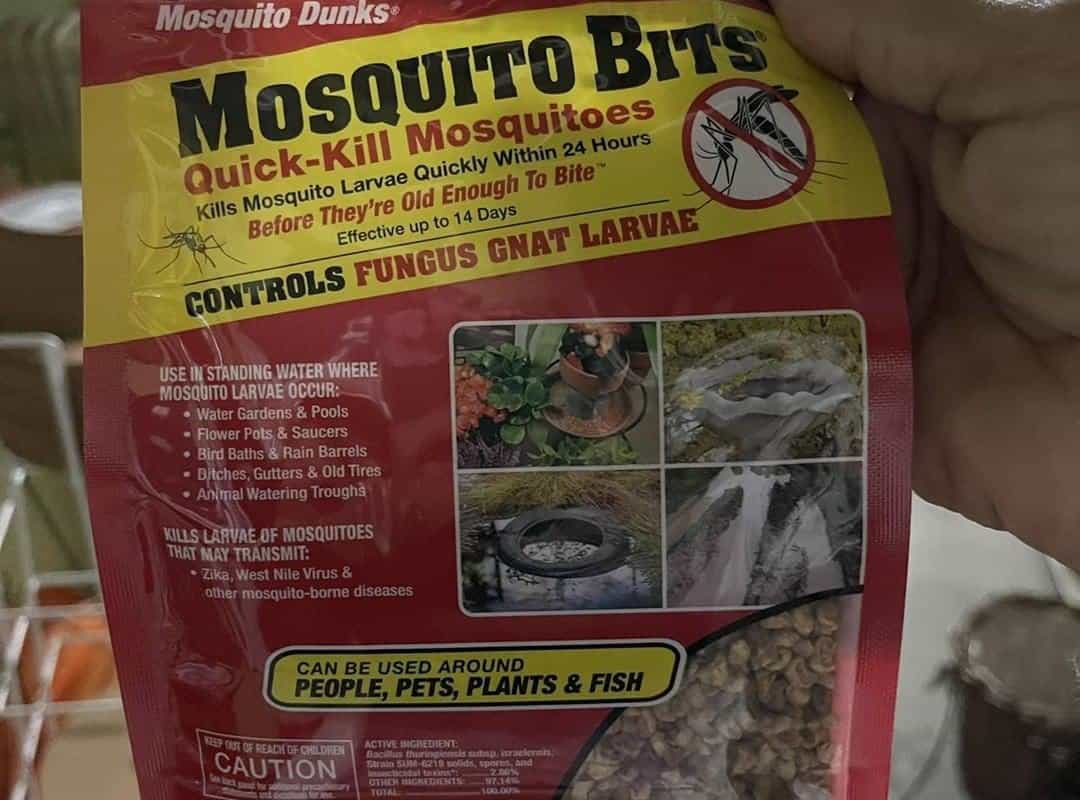
What is the best way to get rid of fungus gnats? I bet that everyone will find an answer that will match the needs of every buyer. But when talking about Summit mosquito bits, I’d say that this option can be easily assigned to the list of the best fungus gnats treatments.
Summit solutions bits is a universal method of getting rid of mosquitoes, fungus gnats, flies, and many other insects. Mix the bits with the soil or make a solution and pour the water into the potted plant, and the result will be immediate. Dissolve 2 tbsp in half a gallon of water for about 20 minutes, strain the bits out, and water the plants with the solution. It may take 1-3 days for the gnats and larvae to be gone completely.
| Pros: | Cons: |
|
|
4. Bonide (BND95349) Insect Granules: Long-Time Treatment for Fungus Gnat Infestation Removal
[amazon box=”B000BWZ9U8″ template=”vertical” tracking_id=”how-to-get-rid-of-fungus-gnats-20″ button_text=”Check price on Amazon” button_detail=”https://shareasale.com/r.cfm?b=1724849&u=2583381&m=107474&urllink=diypestcontrol%2Ecom%2Fbonide%2Dsystemic%2Dgranules%2Dinsect%2Dcontrol&afftrack=how%20to%20get%20rid%20of%20fungus%20gnats” button_detail_text=”Check price on DIY Pest Control”]
Specifications:
- Active Ingredient: Imidacloprid 0.22%
- Item Dimensions LxWxH: 1 x 1 x 1 inches
- Item Weight: 1 pounds
- Yield: 4 lbs covers: up to 1600 sq. ft.
- Target Species: Adelgids, aphids, armored scales (suppression), fungus gnat larvae, Japanese beetle adults, lace bugs, leaf beetles, elm leaf beetles, viburnum leaf beetles, lily leaf beetles, leafhoppers, glassy winged sharpshooter, leafminers, birch leafminers, boxwood leafminers, mealybugs, pine tip moth larvae, plants bugs, psyllids, root weevil larvae, black vine weevil larvae, sawfly larvae, soft scales, lobate lac scales, thrips, whiteflies, wihte grub larvae, chagers, European chafers, Oriental beetle, asiatic garden beetle
The granular mosquito and fungus gnats repellent by Bonide helps to fight indoor and garden pests effectively. You will achieve the best effect within 2 weeks after the start of use. This ant repellent can be used both dry and as a solution.
Bonide insect granules are useful against flies, mosquitoes, and fungus gnats both inside and outside your house, so you can use it in your garden if needed. You can also use the granules as a prevention method, so the pests will stay out of your property for 2-4 months.
Specially designed for effective and targeted control of harmful insects in residential and public areas, it helps to control flies and their larvae. Also, it quickly and reliably destroys fleas, lice, cockroaches, crickets, ticks, and other insects.
| Pros: | Cons: |
|
|
5. The Best Way for Natural Fungus Gnat Control: AgroMagen (GS420)
[amazon box=”B07M983TRL” template=”vertical” tracking_id=”how-to-get-rid-of-fungus-gnats-20″ button_text=”Check price on Amazon”]
Specifications:
- Active Ingredients: Corn Oil 15%, Coybean Oil 15%
- Item Volume: 8.5 fl. oz.
- Item Dimensions LxWxH: 3.25 x 3.25 x 5.5 inches
- Item Weight: 8.48 Ounces
- Target Species: spider mites (two-spotted mites, broad mites, russet mites), whiteflies, aphids, powdery mildew, and downy mildew
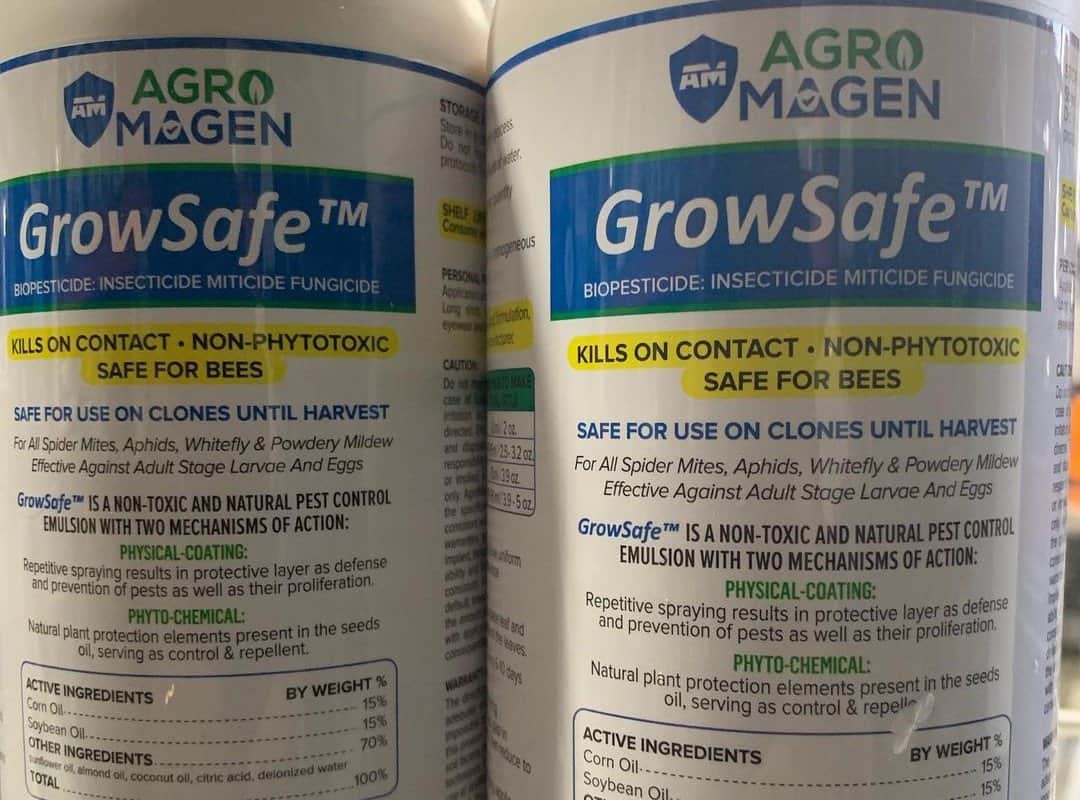
AgroMagen is a universal organic concentrated gnat insecticide for natural fungus gnats control. If you wonder how to kill fungus gnats, this option might become your best choice. AgroMagen Bio-pesticide is not toxic to soil and ground, and it’s also safe for humans and pets. Its composition includes unique oil emulsion, which blends with water perfectly and can be applied for fruit trees and other plants.
AgroMagen GrowSafe is economic, and one pack is enough for using it at least for two months. However, you probably won’t even run out of the product that soon, since its effect is visible just in several days.
| Pros: | Cons: |
|
|
How to prevent fungus gnats
Remember that these pests can fly quickly into the window, so the first thing to do to prevent their appearance is to put a thin mosquito net on the windows. You should also avoid the decay of vegetables, fruits, and other residues from the table in the trash bin and take out the trash regularly.
Root-damaging pests cannot live without moisture. Therefore, your next step is to reduce the watering of the plant. To make it impossible for adult insects to lay eggs, a simple method of protecting the soil helps greatly. It consists of creating a top layer in a flower pot from fine expanded clay, gravel, or sand.
Questions About Soil Gnats
If you still have questions about soil gnats, be sure to check this section of the article.
How long do fungus gnats live?
As it is stated above, adult fungus gnats can live from 5 to seven days. Larvae growth period takes 3-4 days after laying. However, there are also cases when fungus gnats larvae grew in 1-2 days because the soil condition was perfect.
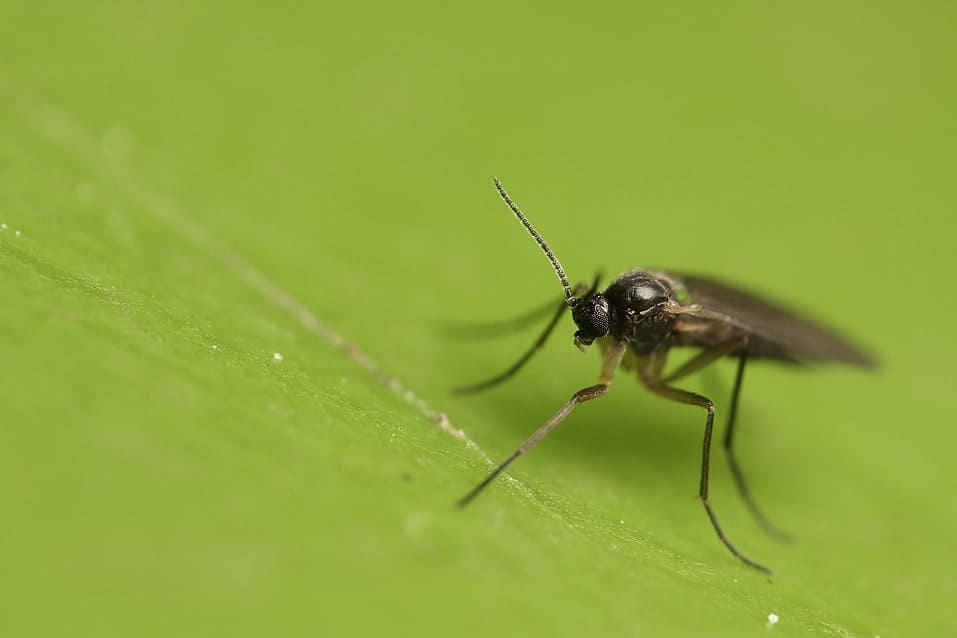
How to bake soil to kill fungus gnats?
If there are a lot of larvae in the soil, and you assume that the plant will withstand the transplant, then it is best to do this by putting the flower into a new, pre-cultivated land. To do this:
- Loosen the soil and carefully pull it out.
- Then manually or with a small brush, clean the roots of the contaminated soil.
- Quickly rinse the roots with water or one of the remedies.
- Finally, transfer the plant into a clean pot with uninfected soil. It is when you will need the baked soil. Put it in the oven at a temperature of 100-120 degrees for 1 hour, and then restore the microflora with some kind of fertilizer.
How to trap fungus gnats?
The best option is to use a fly trap tape near the plants. Also, stock up on sticky fly traps from summer, because they may not have them in stores during winter. Don’t forget to change the tape regularly.
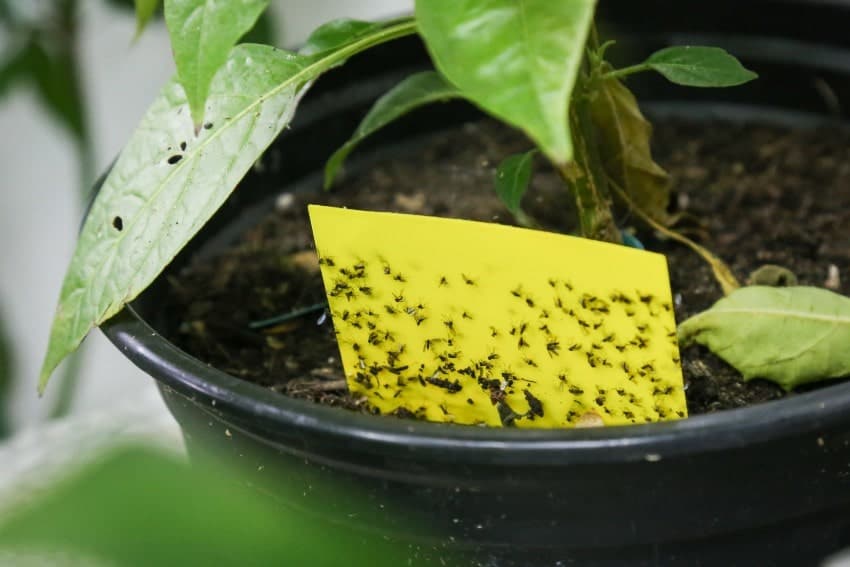
Can dehydration damage my plants?
Why do we even need to water the indoor plants? Why does a plant need water? Weird question. Every living organism needs water. It is a universal solvent that provides the production of energy for people, animals, and plants.
As you know, the plant “feeds” on sunlight, or rather synthesizes organic matter using the sun’s energy from carbon dioxide and water. Therefore, water is the main substance in the life of plants. And of course, dehydration can damage your plants.
How to pick a plant in a store that is not infected?
If you go to the store to buy a new plant or flower, inspect it carefully. First of all, make sure that the stems are developed equally, and there are no yellow or sluggish leaves. After that, check if the plant doesn’t suffer from an infestation of small insects. Examine the plant and see if it has larvae or bugs.

Do You Know How to Get Rid of Fungus Gnats in Houseplants?
Did you find the best way to get rid of fungus gnats? I hope this article helped you to dot the i’s and cross the t’s. Still, the answer to this question will always be different for everyone. The choice of the product depends exactly on your needs.
Anyways, fighting fungus gnats is not a very complicated task to deal with, and I’m sure that you’ll manage it successfully. Do you know any other ways of how to get rid of gnats in soil? Did you ever try to use natural fungus gnat control? Feel free to share your tips and advice in the comments section.
References:
- Fungus Gnats as Houseplant and Indoor Pests(Colorado State University):
https://extension.colostate.edu/topic-areas/insects/fungus-gnats-as-houseplant-and-indoor-pests-5-584/ - True Flies (Diptera) (Smithsonian):
https://www.si.edu/spotlight/buginfo/true-flies-diptera - What organic fertilizers mean to plants and soil(Michigan State University):
https://www.canr.msu.edu/news/what_organic_fertilizers_mean_to_plants_and_soil - Diatomaceous Earth(National Pesticide Information Center):
http://npic.orst.edu/factsheets/degen.html - Hydrogen peroxide (National Library of Medicine):
https://pubchem.ncbi.nlm.nih.gov/compound/Hydrogen-peroxide

